HRM in NatWest Bank
VerifiedAdded on 2023/03/31
|15
|5720
|382
AI Summary
This report provides an overview of the human resource management practices in NatWest Bank and how they contribute to achieving organizational goals. It discusses the recruitment and selection process, training and development programs, performance monitoring and evaluation, and the rewards system. The report also highlights the importance of job and workplace design, organizational flexibility, and the internal and external factors that affect HRM decision-making.
Contribute Materials
Your contribution can guide someone’s learning journey. Share your
documents today.
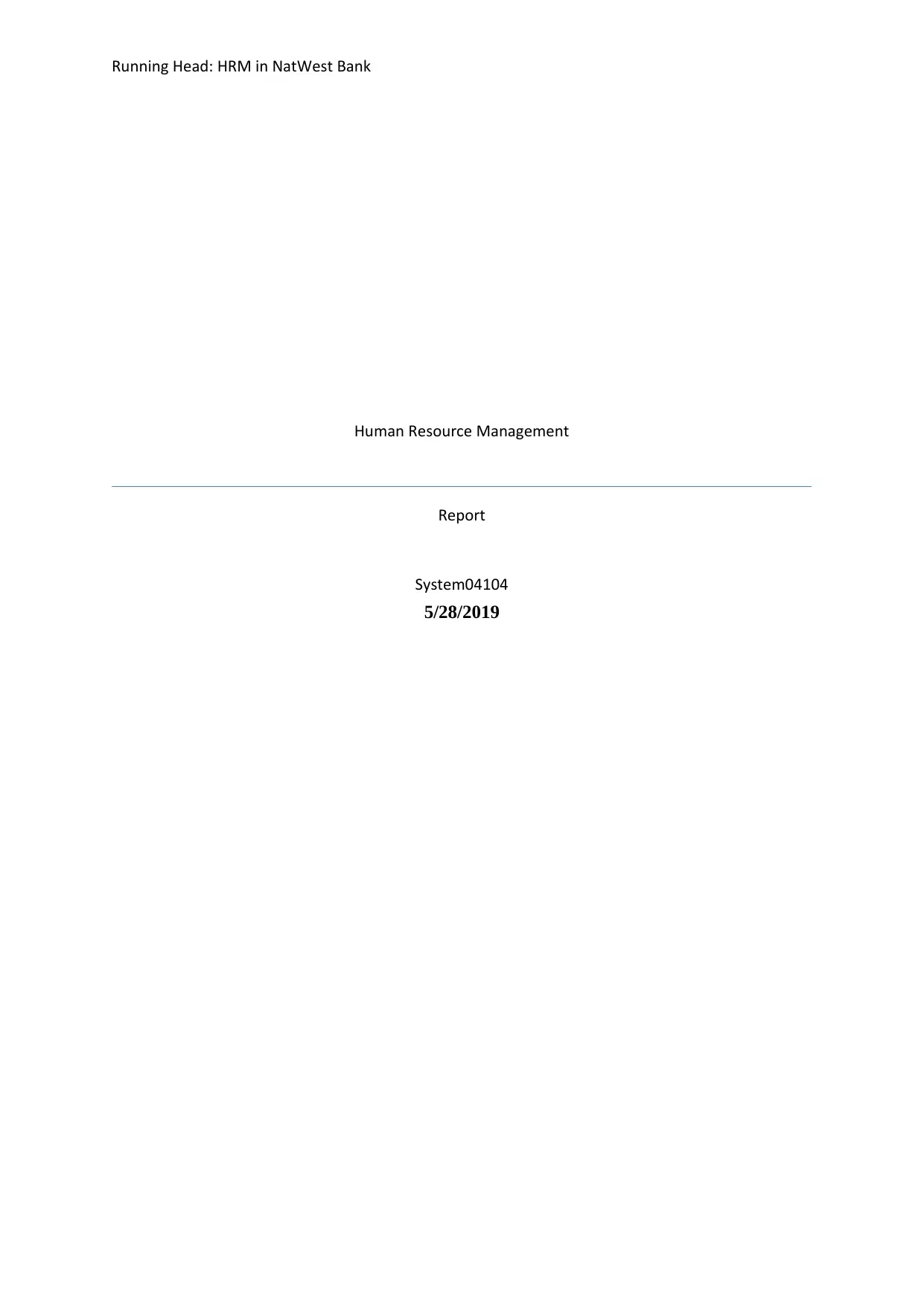
Running Head: HRM in NatWest Bank
Human Resource Management
Report
System04104
5/28/2019
Human Resource Management
Report
System04104
5/28/2019
Secure Best Marks with AI Grader
Need help grading? Try our AI Grader for instant feedback on your assignments.
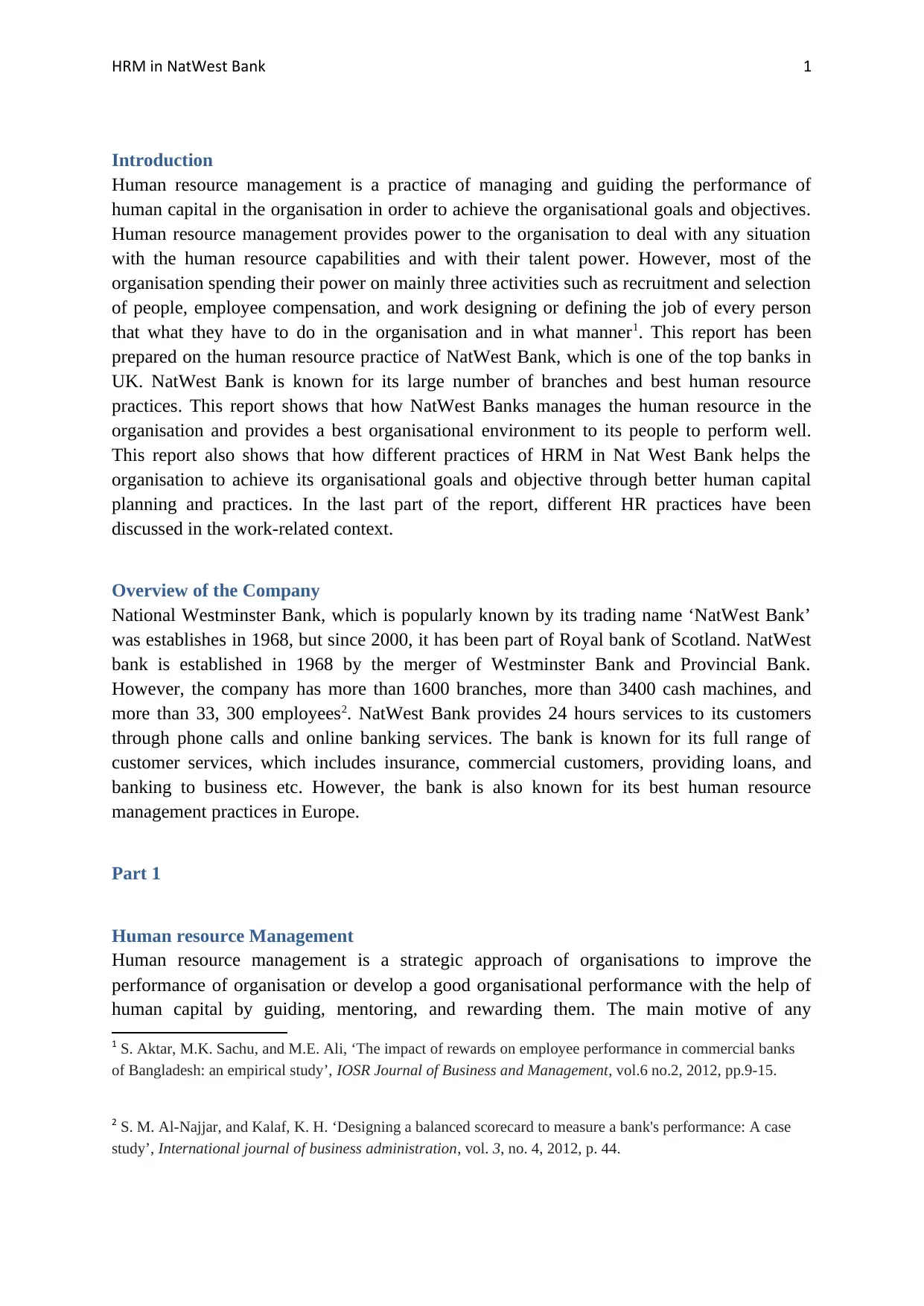
HRM in NatWest Bank 1
Introduction
Human resource management is a practice of managing and guiding the performance of
human capital in the organisation in order to achieve the organisational goals and objectives.
Human resource management provides power to the organisation to deal with any situation
with the human resource capabilities and with their talent power. However, most of the
organisation spending their power on mainly three activities such as recruitment and selection
of people, employee compensation, and work designing or defining the job of every person
that what they have to do in the organisation and in what manner1. This report has been
prepared on the human resource practice of NatWest Bank, which is one of the top banks in
UK. NatWest Bank is known for its large number of branches and best human resource
practices. This report shows that how NatWest Banks manages the human resource in the
organisation and provides a best organisational environment to its people to perform well.
This report also shows that how different practices of HRM in Nat West Bank helps the
organisation to achieve its organisational goals and objective through better human capital
planning and practices. In the last part of the report, different HR practices have been
discussed in the work-related context.
Overview of the Company
National Westminster Bank, which is popularly known by its trading name ‘NatWest Bank’
was establishes in 1968, but since 2000, it has been part of Royal bank of Scotland. NatWest
bank is established in 1968 by the merger of Westminster Bank and Provincial Bank.
However, the company has more than 1600 branches, more than 3400 cash machines, and
more than 33, 300 employees2. NatWest Bank provides 24 hours services to its customers
through phone calls and online banking services. The bank is known for its full range of
customer services, which includes insurance, commercial customers, providing loans, and
banking to business etc. However, the bank is also known for its best human resource
management practices in Europe.
Part 1
Human resource Management
Human resource management is a strategic approach of organisations to improve the
performance of organisation or develop a good organisational performance with the help of
human capital by guiding, mentoring, and rewarding them. The main motive of any
1 S. Aktar, M.K. Sachu, and M.E. Ali, ‘The impact of rewards on employee performance in commercial banks
of Bangladesh: an empirical study’, IOSR Journal of Business and Management, vol.6 no.2, 2012, pp.9-15.
2 S. M. Al-Najjar, and Kalaf, K. H. ‘Designing a balanced scorecard to measure a bank's performance: A case
study’, International journal of business administration, vol. 3, no. 4, 2012, p. 44.
Introduction
Human resource management is a practice of managing and guiding the performance of
human capital in the organisation in order to achieve the organisational goals and objectives.
Human resource management provides power to the organisation to deal with any situation
with the human resource capabilities and with their talent power. However, most of the
organisation spending their power on mainly three activities such as recruitment and selection
of people, employee compensation, and work designing or defining the job of every person
that what they have to do in the organisation and in what manner1. This report has been
prepared on the human resource practice of NatWest Bank, which is one of the top banks in
UK. NatWest Bank is known for its large number of branches and best human resource
practices. This report shows that how NatWest Banks manages the human resource in the
organisation and provides a best organisational environment to its people to perform well.
This report also shows that how different practices of HRM in Nat West Bank helps the
organisation to achieve its organisational goals and objective through better human capital
planning and practices. In the last part of the report, different HR practices have been
discussed in the work-related context.
Overview of the Company
National Westminster Bank, which is popularly known by its trading name ‘NatWest Bank’
was establishes in 1968, but since 2000, it has been part of Royal bank of Scotland. NatWest
bank is established in 1968 by the merger of Westminster Bank and Provincial Bank.
However, the company has more than 1600 branches, more than 3400 cash machines, and
more than 33, 300 employees2. NatWest Bank provides 24 hours services to its customers
through phone calls and online banking services. The bank is known for its full range of
customer services, which includes insurance, commercial customers, providing loans, and
banking to business etc. However, the bank is also known for its best human resource
management practices in Europe.
Part 1
Human resource Management
Human resource management is a strategic approach of organisations to improve the
performance of organisation or develop a good organisational performance with the help of
human capital by guiding, mentoring, and rewarding them. The main motive of any
1 S. Aktar, M.K. Sachu, and M.E. Ali, ‘The impact of rewards on employee performance in commercial banks
of Bangladesh: an empirical study’, IOSR Journal of Business and Management, vol.6 no.2, 2012, pp.9-15.
2 S. M. Al-Najjar, and Kalaf, K. H. ‘Designing a balanced scorecard to measure a bank's performance: A case
study’, International journal of business administration, vol. 3, no. 4, 2012, p. 44.

HRM in NatWest Bank 2
organisation to effectively use the human resource of the organisation thus the goals and
objectives of the organisation will be affectively and efficiently achieved. HRM also helps to
recruit talented people, provide them training to develop their skills and knowledge, and
provide effective direction and rewards in order to achieve the organisational target. Human
are the precious asset of the organisation and HRM helps to manage the human capital in
such a way that helps the organisation in attaining its goals. However, HRM is a function of
organisation that deals in recruitment, selection, training, evaluation of the performance, and
proving rewards to the employees for their performance. However, the NatWest Bank is
known for its best human resource practices as it provides best organisational environment to
its employees and workers3.
Different approaches used by NatWest bank in recruitment and selection off people
The major functions in the human resource department of the NatWest Bank are as follow:
1. Recruitment and selection
In this function of human resource management, organisation recruits and selects best people
who are talented and eligible for the jobs in the organisation. In the staffing process, the
NatWest Bank offers job description and job specification for the candidates who want to join
NatWest bank and are eligible for the job. When there will be requirement of people in the
organisation, the bank will submit a job description to its HR department and ask for
recruiting people. The job description specifies the HR department that how many people are
required on what places of the organisation. Then after, the HR department in the bank is
looking for searching people for the vacant posts in the organisation. However, the first
priority of recruitment board and H department of NatWest Bank is to recruit people from the
internal sources of the organisation. However, if any staff or person has required skills and
qualifications, the NatWest Bank selects the person for that vacant post. In other way, if the
all vacant posts cannot be fulfil by the internal sources, organisation will advertise about the
requirements in the media channels such as TV news, on its websites, on the job portals, and
through the social media groups about it requirement for the job and invites the application of
candidates for the job4. Then after, the organisation select the right profiles through screening
the resumes or CVs of people and called those candidates who are eligible for the job for
further conduct a personal interview of people. After the personal interview, the final
candidates will be selected for the job position. However, in NatWest Bank, the referrals of
employees are also considered by the human resource department for recruitment and
selection of people in the organisation.
Strength and weakness of different approaches of recruitment and selection
3 E. Rasoulinezhad, ‘Measuring the role of knowledge management processes in the commercial banks of
Iran’, Electronic Journal of Knowledge Management, vol. 9, no. 4, 2011, p.353.
4 M.Z. Alam, and M. Musukujjaman, ‘Risk management practices: A critical diagnosis of some selected
commercial banks in Bangladesh’, Journal of Business and Technology (Dhaka), vol. 6, no.1, 2011, pp.15-35.
organisation to effectively use the human resource of the organisation thus the goals and
objectives of the organisation will be affectively and efficiently achieved. HRM also helps to
recruit talented people, provide them training to develop their skills and knowledge, and
provide effective direction and rewards in order to achieve the organisational target. Human
are the precious asset of the organisation and HRM helps to manage the human capital in
such a way that helps the organisation in attaining its goals. However, HRM is a function of
organisation that deals in recruitment, selection, training, evaluation of the performance, and
proving rewards to the employees for their performance. However, the NatWest Bank is
known for its best human resource practices as it provides best organisational environment to
its employees and workers3.
Different approaches used by NatWest bank in recruitment and selection off people
The major functions in the human resource department of the NatWest Bank are as follow:
1. Recruitment and selection
In this function of human resource management, organisation recruits and selects best people
who are talented and eligible for the jobs in the organisation. In the staffing process, the
NatWest Bank offers job description and job specification for the candidates who want to join
NatWest bank and are eligible for the job. When there will be requirement of people in the
organisation, the bank will submit a job description to its HR department and ask for
recruiting people. The job description specifies the HR department that how many people are
required on what places of the organisation. Then after, the HR department in the bank is
looking for searching people for the vacant posts in the organisation. However, the first
priority of recruitment board and H department of NatWest Bank is to recruit people from the
internal sources of the organisation. However, if any staff or person has required skills and
qualifications, the NatWest Bank selects the person for that vacant post. In other way, if the
all vacant posts cannot be fulfil by the internal sources, organisation will advertise about the
requirements in the media channels such as TV news, on its websites, on the job portals, and
through the social media groups about it requirement for the job and invites the application of
candidates for the job4. Then after, the organisation select the right profiles through screening
the resumes or CVs of people and called those candidates who are eligible for the job for
further conduct a personal interview of people. After the personal interview, the final
candidates will be selected for the job position. However, in NatWest Bank, the referrals of
employees are also considered by the human resource department for recruitment and
selection of people in the organisation.
Strength and weakness of different approaches of recruitment and selection
3 E. Rasoulinezhad, ‘Measuring the role of knowledge management processes in the commercial banks of
Iran’, Electronic Journal of Knowledge Management, vol. 9, no. 4, 2011, p.353.
4 M.Z. Alam, and M. Musukujjaman, ‘Risk management practices: A critical diagnosis of some selected
commercial banks in Bangladesh’, Journal of Business and Technology (Dhaka), vol. 6, no.1, 2011, pp.15-35.
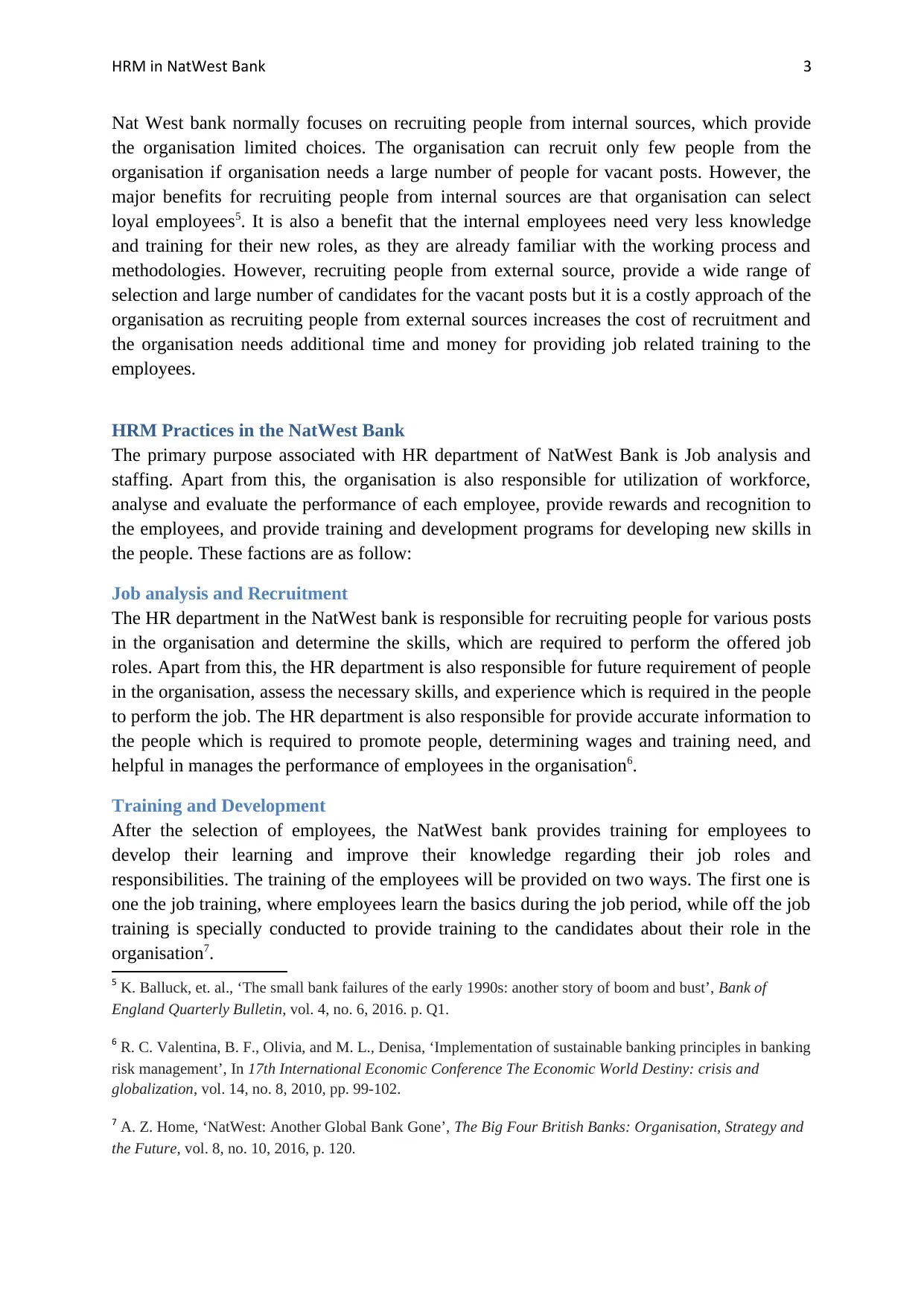
HRM in NatWest Bank 3
Nat West bank normally focuses on recruiting people from internal sources, which provide
the organisation limited choices. The organisation can recruit only few people from the
organisation if organisation needs a large number of people for vacant posts. However, the
major benefits for recruiting people from internal sources are that organisation can select
loyal employees5. It is also a benefit that the internal employees need very less knowledge
and training for their new roles, as they are already familiar with the working process and
methodologies. However, recruiting people from external source, provide a wide range of
selection and large number of candidates for the vacant posts but it is a costly approach of the
organisation as recruiting people from external sources increases the cost of recruitment and
the organisation needs additional time and money for providing job related training to the
employees.
HRM Practices in the NatWest Bank
The primary purpose associated with HR department of NatWest Bank is Job analysis and
staffing. Apart from this, the organisation is also responsible for utilization of workforce,
analyse and evaluate the performance of each employee, provide rewards and recognition to
the employees, and provide training and development programs for developing new skills in
the people. These factions are as follow:
Job analysis and Recruitment
The HR department in the NatWest bank is responsible for recruiting people for various posts
in the organisation and determine the skills, which are required to perform the offered job
roles. Apart from this, the HR department is also responsible for future requirement of people
in the organisation, assess the necessary skills, and experience which is required in the people
to perform the job. The HR department is also responsible for provide accurate information to
the people which is required to promote people, determining wages and training need, and
helpful in manages the performance of employees in the organisation6.
Training and Development
After the selection of employees, the NatWest bank provides training for employees to
develop their learning and improve their knowledge regarding their job roles and
responsibilities. The training of the employees will be provided on two ways. The first one is
one the job training, where employees learn the basics during the job period, while off the job
training is specially conducted to provide training to the candidates about their role in the
organisation7.
5 K. Balluck, et. al., ‘The small bank failures of the early 1990s: another story of boom and bust’, Bank of
England Quarterly Bulletin, vol. 4, no. 6, 2016. p. Q1.
6 R. C. Valentina, B. F., Olivia, and M. L., Denisa, ‘Implementation of sustainable banking principles in banking
risk management’, In 17th International Economic Conference The Economic World Destiny: crisis and
globalization, vol. 14, no. 8, 2010, pp. 99-102.
7 A. Z. Home, ‘NatWest: Another Global Bank Gone’, The Big Four British Banks: Organisation, Strategy and
the Future, vol. 8, no. 10, 2016, p. 120.
Nat West bank normally focuses on recruiting people from internal sources, which provide
the organisation limited choices. The organisation can recruit only few people from the
organisation if organisation needs a large number of people for vacant posts. However, the
major benefits for recruiting people from internal sources are that organisation can select
loyal employees5. It is also a benefit that the internal employees need very less knowledge
and training for their new roles, as they are already familiar with the working process and
methodologies. However, recruiting people from external source, provide a wide range of
selection and large number of candidates for the vacant posts but it is a costly approach of the
organisation as recruiting people from external sources increases the cost of recruitment and
the organisation needs additional time and money for providing job related training to the
employees.
HRM Practices in the NatWest Bank
The primary purpose associated with HR department of NatWest Bank is Job analysis and
staffing. Apart from this, the organisation is also responsible for utilization of workforce,
analyse and evaluate the performance of each employee, provide rewards and recognition to
the employees, and provide training and development programs for developing new skills in
the people. These factions are as follow:
Job analysis and Recruitment
The HR department in the NatWest bank is responsible for recruiting people for various posts
in the organisation and determine the skills, which are required to perform the offered job
roles. Apart from this, the HR department is also responsible for future requirement of people
in the organisation, assess the necessary skills, and experience which is required in the people
to perform the job. The HR department is also responsible for provide accurate information to
the people which is required to promote people, determining wages and training need, and
helpful in manages the performance of employees in the organisation6.
Training and Development
After the selection of employees, the NatWest bank provides training for employees to
develop their learning and improve their knowledge regarding their job roles and
responsibilities. The training of the employees will be provided on two ways. The first one is
one the job training, where employees learn the basics during the job period, while off the job
training is specially conducted to provide training to the candidates about their role in the
organisation7.
5 K. Balluck, et. al., ‘The small bank failures of the early 1990s: another story of boom and bust’, Bank of
England Quarterly Bulletin, vol. 4, no. 6, 2016. p. Q1.
6 R. C. Valentina, B. F., Olivia, and M. L., Denisa, ‘Implementation of sustainable banking principles in banking
risk management’, In 17th International Economic Conference The Economic World Destiny: crisis and
globalization, vol. 14, no. 8, 2010, pp. 99-102.
7 A. Z. Home, ‘NatWest: Another Global Bank Gone’, The Big Four British Banks: Organisation, Strategy and
the Future, vol. 8, no. 10, 2016, p. 120.
Secure Best Marks with AI Grader
Need help grading? Try our AI Grader for instant feedback on your assignments.
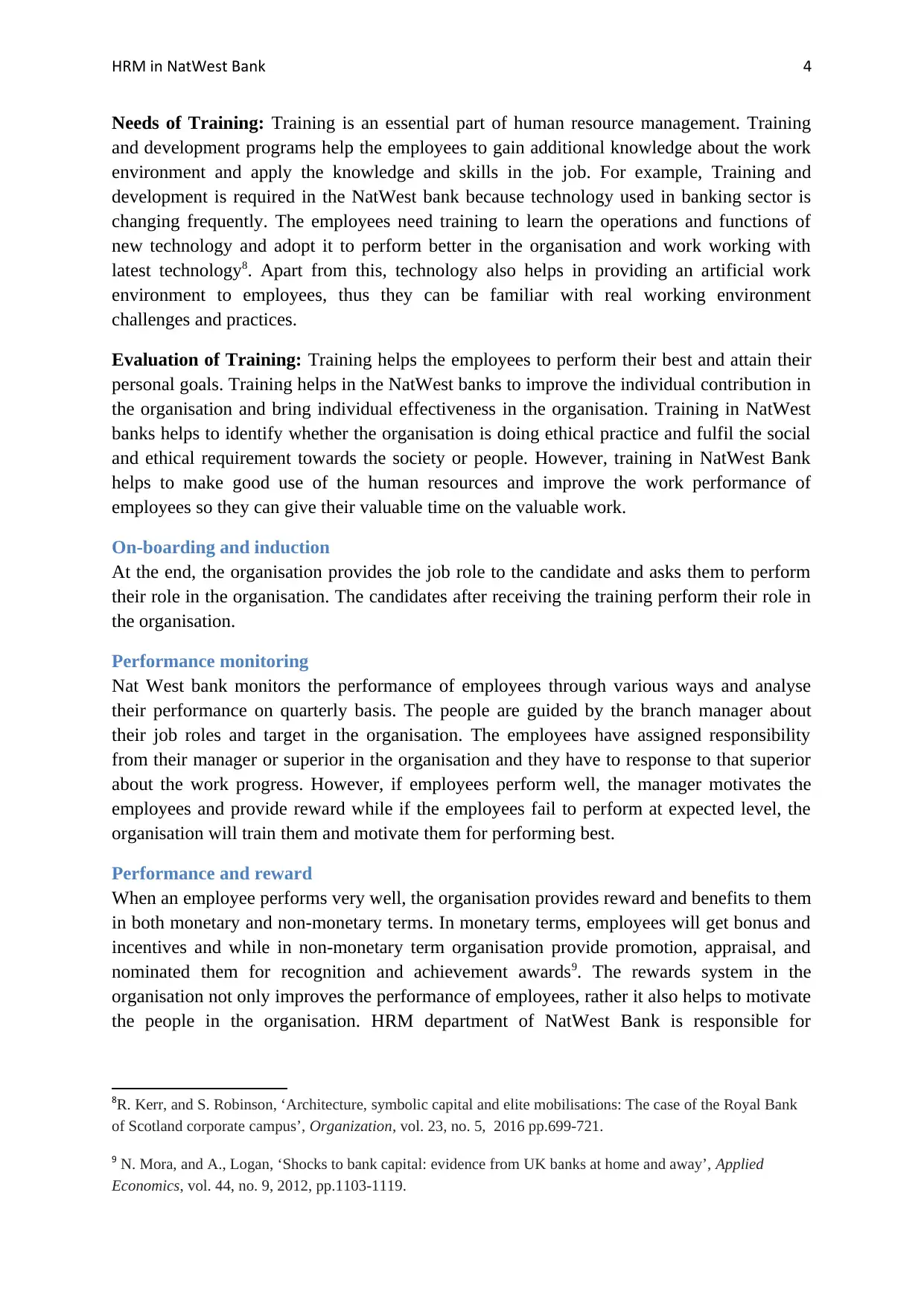
HRM in NatWest Bank 4
Needs of Training: Training is an essential part of human resource management. Training
and development programs help the employees to gain additional knowledge about the work
environment and apply the knowledge and skills in the job. For example, Training and
development is required in the NatWest bank because technology used in banking sector is
changing frequently. The employees need training to learn the operations and functions of
new technology and adopt it to perform better in the organisation and work working with
latest technology8. Apart from this, technology also helps in providing an artificial work
environment to employees, thus they can be familiar with real working environment
challenges and practices.
Evaluation of Training: Training helps the employees to perform their best and attain their
personal goals. Training helps in the NatWest banks to improve the individual contribution in
the organisation and bring individual effectiveness in the organisation. Training in NatWest
banks helps to identify whether the organisation is doing ethical practice and fulfil the social
and ethical requirement towards the society or people. However, training in NatWest Bank
helps to make good use of the human resources and improve the work performance of
employees so they can give their valuable time on the valuable work.
On-boarding and induction
At the end, the organisation provides the job role to the candidate and asks them to perform
their role in the organisation. The candidates after receiving the training perform their role in
the organisation.
Performance monitoring
Nat West bank monitors the performance of employees through various ways and analyse
their performance on quarterly basis. The people are guided by the branch manager about
their job roles and target in the organisation. The employees have assigned responsibility
from their manager or superior in the organisation and they have to response to that superior
about the work progress. However, if employees perform well, the manager motivates the
employees and provide reward while if the employees fail to perform at expected level, the
organisation will train them and motivate them for performing best.
Performance and reward
When an employee performs very well, the organisation provides reward and benefits to them
in both monetary and non-monetary terms. In monetary terms, employees will get bonus and
incentives and while in non-monetary term organisation provide promotion, appraisal, and
nominated them for recognition and achievement awards9. The rewards system in the
organisation not only improves the performance of employees, rather it also helps to motivate
the people in the organisation. HRM department of NatWest Bank is responsible for
8R. Kerr, and S. Robinson, ‘Architecture, symbolic capital and elite mobilisations: The case of the Royal Bank
of Scotland corporate campus’, Organization, vol. 23, no. 5, 2016 pp.699-721.
9 N. Mora, and A., Logan, ‘Shocks to bank capital: evidence from UK banks at home and away’, Applied
Economics, vol. 44, no. 9, 2012, pp.1103-1119.
Needs of Training: Training is an essential part of human resource management. Training
and development programs help the employees to gain additional knowledge about the work
environment and apply the knowledge and skills in the job. For example, Training and
development is required in the NatWest bank because technology used in banking sector is
changing frequently. The employees need training to learn the operations and functions of
new technology and adopt it to perform better in the organisation and work working with
latest technology8. Apart from this, technology also helps in providing an artificial work
environment to employees, thus they can be familiar with real working environment
challenges and practices.
Evaluation of Training: Training helps the employees to perform their best and attain their
personal goals. Training helps in the NatWest banks to improve the individual contribution in
the organisation and bring individual effectiveness in the organisation. Training in NatWest
banks helps to identify whether the organisation is doing ethical practice and fulfil the social
and ethical requirement towards the society or people. However, training in NatWest Bank
helps to make good use of the human resources and improve the work performance of
employees so they can give their valuable time on the valuable work.
On-boarding and induction
At the end, the organisation provides the job role to the candidate and asks them to perform
their role in the organisation. The candidates after receiving the training perform their role in
the organisation.
Performance monitoring
Nat West bank monitors the performance of employees through various ways and analyse
their performance on quarterly basis. The people are guided by the branch manager about
their job roles and target in the organisation. The employees have assigned responsibility
from their manager or superior in the organisation and they have to response to that superior
about the work progress. However, if employees perform well, the manager motivates the
employees and provide reward while if the employees fail to perform at expected level, the
organisation will train them and motivate them for performing best.
Performance and reward
When an employee performs very well, the organisation provides reward and benefits to them
in both monetary and non-monetary terms. In monetary terms, employees will get bonus and
incentives and while in non-monetary term organisation provide promotion, appraisal, and
nominated them for recognition and achievement awards9. The rewards system in the
organisation not only improves the performance of employees, rather it also helps to motivate
the people in the organisation. HRM department of NatWest Bank is responsible for
8R. Kerr, and S. Robinson, ‘Architecture, symbolic capital and elite mobilisations: The case of the Royal Bank
of Scotland corporate campus’, Organization, vol. 23, no. 5, 2016 pp.699-721.
9 N. Mora, and A., Logan, ‘Shocks to bank capital: evidence from UK banks at home and away’, Applied
Economics, vol. 44, no. 9, 2012, pp.1103-1119.

HRM in NatWest Bank 5
analysing and evaluating ye performance of employees and then assess the performance
against the set criteria and then provide reward for the best performance in the organisation10.
Job and workplace design
Job design is a process of work arrangement and distribution of work that aimed to reduce the
dissatisfaction among people and maximising their effort towards the organisation. The
NatWest Bank is responsible to provide a best work environment to the people and introduce
new job roles on frequently basis for the people. For example, NatWest Bank rotates the jib
of people in the organisation thus, they can never frustrate with a single type of work. Apart
from this, the organisation provides a fix process for every job roles that further help the
people to perform their job roles easily and in pre-set criteria. The organisation focuses on
assigning the jobs to those people who can easily perform it. The job design of the
organisation is determine the human resource department and every one assigned a
challenging job that motivates them11.
Organisational Flexibility
The organisation flexibility refers to relaxation related to work timings or schedule. NatWest
Bank provides facilities to its workers to work from the home or taking leaves when they
required. The flexibility in working conditions helps the people to work freely. For example,
NatWest Banks allows its employees to work near their home branch which helps the
employees to travel and it not only help them to save their energy which is consumed in
travelling time, it will also help in saving fuels and protect the environment from protection
as well. However, the organisation is also responsible for safe work practices and it further
affects the satisfaction and motivation level of employees. However, organisational flexibility
in works and safety of people also help in healthy body and mind conditions even after the
long working hours12.
Internal and External Factors that affect the HRM decision-making
The human resource management in the organisation is responsible for maintaining a good
relationship between the employers and employees. However, the role of HR department in
the organisation is not limited to hiring and training of the employees, rather it is also
10N. Ferreira, ‘Hardiness in relation to organisational commitment in the human resource management
field’, SA Journal of Human Resource Management, vol. 10, no. 2, 2012 pp.1-10.
11 N. Kaya, E. Koc, and D. Topcu, An exploratory analysis of the influence of human resource management
activities and organizational climate on job satisfaction in Turkish banks. The International Journal of Human
Resource Management, vol. 21, no. 11, 2010, pp.2031-2051.
12 C. MacKenzie, T.N., Garavan, and R., Carbery, ‘Understanding and preventing dysfunctional behavior in
organizations: conceptualizing the contribution of human resource development’, Human Resource
Development Review, vol. 10, no. 4, 2011, pp.346-380.
analysing and evaluating ye performance of employees and then assess the performance
against the set criteria and then provide reward for the best performance in the organisation10.
Job and workplace design
Job design is a process of work arrangement and distribution of work that aimed to reduce the
dissatisfaction among people and maximising their effort towards the organisation. The
NatWest Bank is responsible to provide a best work environment to the people and introduce
new job roles on frequently basis for the people. For example, NatWest Bank rotates the jib
of people in the organisation thus, they can never frustrate with a single type of work. Apart
from this, the organisation provides a fix process for every job roles that further help the
people to perform their job roles easily and in pre-set criteria. The organisation focuses on
assigning the jobs to those people who can easily perform it. The job design of the
organisation is determine the human resource department and every one assigned a
challenging job that motivates them11.
Organisational Flexibility
The organisation flexibility refers to relaxation related to work timings or schedule. NatWest
Bank provides facilities to its workers to work from the home or taking leaves when they
required. The flexibility in working conditions helps the people to work freely. For example,
NatWest Banks allows its employees to work near their home branch which helps the
employees to travel and it not only help them to save their energy which is consumed in
travelling time, it will also help in saving fuels and protect the environment from protection
as well. However, the organisation is also responsible for safe work practices and it further
affects the satisfaction and motivation level of employees. However, organisational flexibility
in works and safety of people also help in healthy body and mind conditions even after the
long working hours12.
Internal and External Factors that affect the HRM decision-making
The human resource management in the organisation is responsible for maintaining a good
relationship between the employers and employees. However, the role of HR department in
the organisation is not limited to hiring and training of the employees, rather it is also
10N. Ferreira, ‘Hardiness in relation to organisational commitment in the human resource management
field’, SA Journal of Human Resource Management, vol. 10, no. 2, 2012 pp.1-10.
11 N. Kaya, E. Koc, and D. Topcu, An exploratory analysis of the influence of human resource management
activities and organizational climate on job satisfaction in Turkish banks. The International Journal of Human
Resource Management, vol. 21, no. 11, 2010, pp.2031-2051.
12 C. MacKenzie, T.N., Garavan, and R., Carbery, ‘Understanding and preventing dysfunctional behavior in
organizations: conceptualizing the contribution of human resource development’, Human Resource
Development Review, vol. 10, no. 4, 2011, pp.346-380.
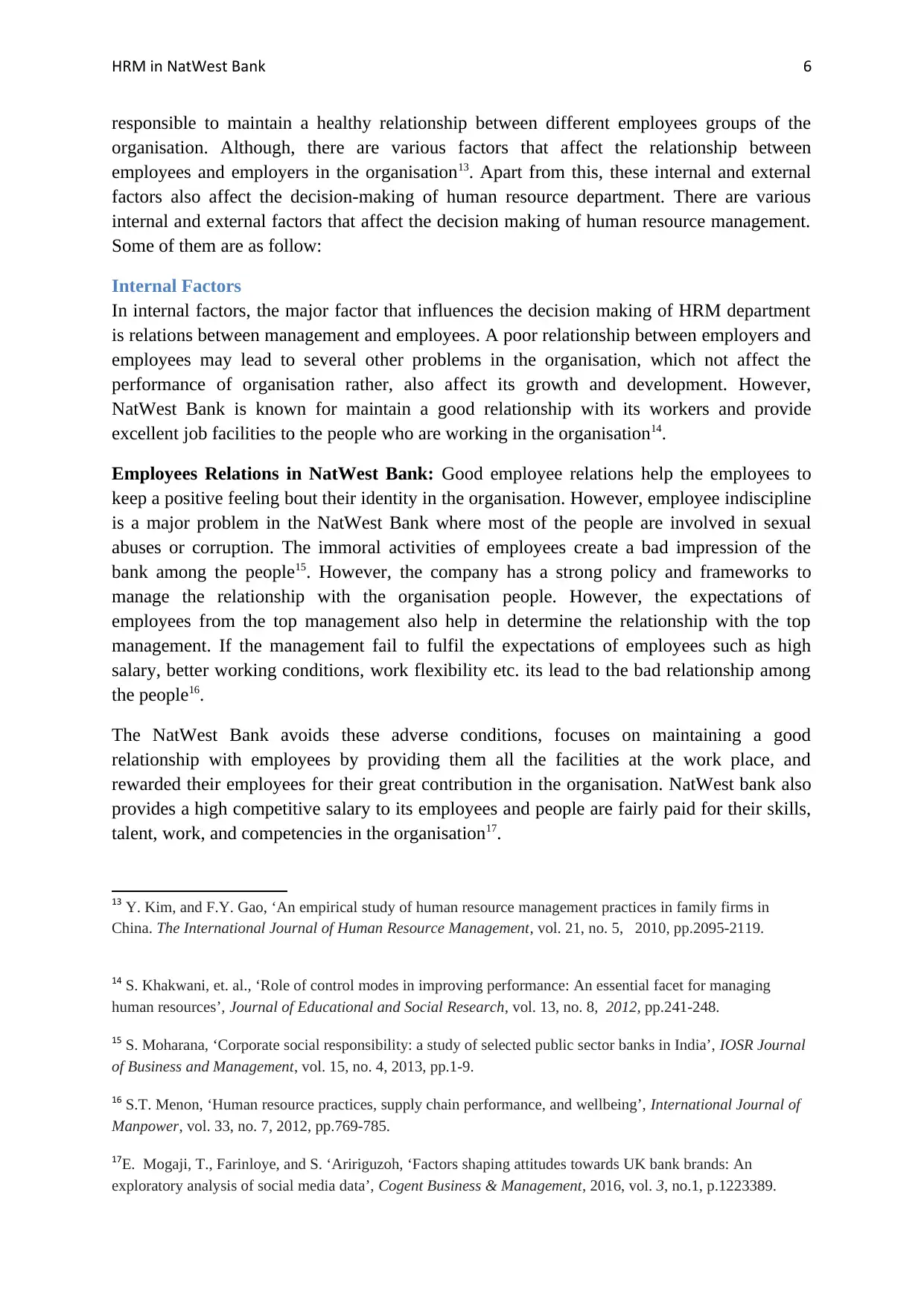
HRM in NatWest Bank 6
responsible to maintain a healthy relationship between different employees groups of the
organisation. Although, there are various factors that affect the relationship between
employees and employers in the organisation13. Apart from this, these internal and external
factors also affect the decision-making of human resource department. There are various
internal and external factors that affect the decision making of human resource management.
Some of them are as follow:
Internal Factors
In internal factors, the major factor that influences the decision making of HRM department
is relations between management and employees. A poor relationship between employers and
employees may lead to several other problems in the organisation, which not affect the
performance of organisation rather, also affect its growth and development. However,
NatWest Bank is known for maintain a good relationship with its workers and provide
excellent job facilities to the people who are working in the organisation14.
Employees Relations in NatWest Bank: Good employee relations help the employees to
keep a positive feeling bout their identity in the organisation. However, employee indiscipline
is a major problem in the NatWest Bank where most of the people are involved in sexual
abuses or corruption. The immoral activities of employees create a bad impression of the
bank among the people15. However, the company has a strong policy and frameworks to
manage the relationship with the organisation people. However, the expectations of
employees from the top management also help in determine the relationship with the top
management. If the management fail to fulfil the expectations of employees such as high
salary, better working conditions, work flexibility etc. its lead to the bad relationship among
the people16.
The NatWest Bank avoids these adverse conditions, focuses on maintaining a good
relationship with employees by providing them all the facilities at the work place, and
rewarded their employees for their great contribution in the organisation. NatWest bank also
provides a high competitive salary to its employees and people are fairly paid for their skills,
talent, work, and competencies in the organisation17.
13 Y. Kim, and F.Y. Gao, ‘An empirical study of human resource management practices in family firms in
China. The International Journal of Human Resource Management, vol. 21, no. 5, 2010, pp.2095-2119.
14 S. Khakwani, et. al., ‘Role of control modes in improving performance: An essential facet for managing
human resources’, Journal of Educational and Social Research, vol. 13, no. 8, 2012, pp.241-248.
15 S. Moharana, ‘Corporate social responsibility: a study of selected public sector banks in India’, IOSR Journal
of Business and Management, vol. 15, no. 4, 2013, pp.1-9.
16 S.T. Menon, ‘Human resource practices, supply chain performance, and wellbeing’, International Journal of
Manpower, vol. 33, no. 7, 2012, pp.769-785.
17E. Mogaji, T., Farinloye, and S. ‘Aririguzoh, ‘Factors shaping attitudes towards UK bank brands: An
exploratory analysis of social media data’, Cogent Business & Management, 2016, vol. 3, no.1, p.1223389.
responsible to maintain a healthy relationship between different employees groups of the
organisation. Although, there are various factors that affect the relationship between
employees and employers in the organisation13. Apart from this, these internal and external
factors also affect the decision-making of human resource department. There are various
internal and external factors that affect the decision making of human resource management.
Some of them are as follow:
Internal Factors
In internal factors, the major factor that influences the decision making of HRM department
is relations between management and employees. A poor relationship between employers and
employees may lead to several other problems in the organisation, which not affect the
performance of organisation rather, also affect its growth and development. However,
NatWest Bank is known for maintain a good relationship with its workers and provide
excellent job facilities to the people who are working in the organisation14.
Employees Relations in NatWest Bank: Good employee relations help the employees to
keep a positive feeling bout their identity in the organisation. However, employee indiscipline
is a major problem in the NatWest Bank where most of the people are involved in sexual
abuses or corruption. The immoral activities of employees create a bad impression of the
bank among the people15. However, the company has a strong policy and frameworks to
manage the relationship with the organisation people. However, the expectations of
employees from the top management also help in determine the relationship with the top
management. If the management fail to fulfil the expectations of employees such as high
salary, better working conditions, work flexibility etc. its lead to the bad relationship among
the people16.
The NatWest Bank avoids these adverse conditions, focuses on maintaining a good
relationship with employees by providing them all the facilities at the work place, and
rewarded their employees for their great contribution in the organisation. NatWest bank also
provides a high competitive salary to its employees and people are fairly paid for their skills,
talent, work, and competencies in the organisation17.
13 Y. Kim, and F.Y. Gao, ‘An empirical study of human resource management practices in family firms in
China. The International Journal of Human Resource Management, vol. 21, no. 5, 2010, pp.2095-2119.
14 S. Khakwani, et. al., ‘Role of control modes in improving performance: An essential facet for managing
human resources’, Journal of Educational and Social Research, vol. 13, no. 8, 2012, pp.241-248.
15 S. Moharana, ‘Corporate social responsibility: a study of selected public sector banks in India’, IOSR Journal
of Business and Management, vol. 15, no. 4, 2013, pp.1-9.
16 S.T. Menon, ‘Human resource practices, supply chain performance, and wellbeing’, International Journal of
Manpower, vol. 33, no. 7, 2012, pp.769-785.
17E. Mogaji, T., Farinloye, and S. ‘Aririguzoh, ‘Factors shaping attitudes towards UK bank brands: An
exploratory analysis of social media data’, Cogent Business & Management, 2016, vol. 3, no.1, p.1223389.
Paraphrase This Document
Need a fresh take? Get an instant paraphrase of this document with our AI Paraphraser
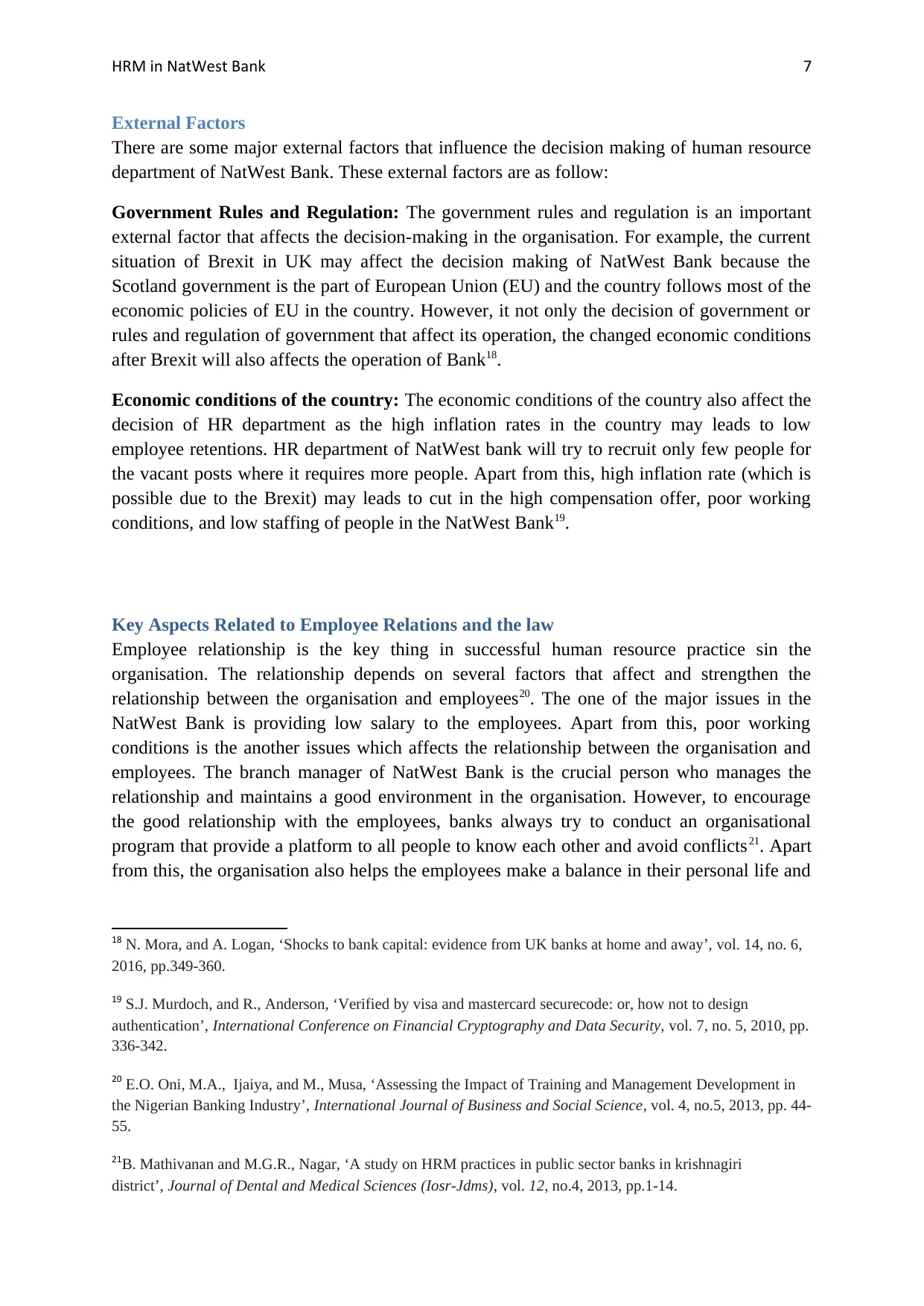
HRM in NatWest Bank 7
External Factors
There are some major external factors that influence the decision making of human resource
department of NatWest Bank. These external factors are as follow:
Government Rules and Regulation: The government rules and regulation is an important
external factor that affects the decision-making in the organisation. For example, the current
situation of Brexit in UK may affect the decision making of NatWest Bank because the
Scotland government is the part of European Union (EU) and the country follows most of the
economic policies of EU in the country. However, it not only the decision of government or
rules and regulation of government that affect its operation, the changed economic conditions
after Brexit will also affects the operation of Bank18.
Economic conditions of the country: The economic conditions of the country also affect the
decision of HR department as the high inflation rates in the country may leads to low
employee retentions. HR department of NatWest bank will try to recruit only few people for
the vacant posts where it requires more people. Apart from this, high inflation rate (which is
possible due to the Brexit) may leads to cut in the high compensation offer, poor working
conditions, and low staffing of people in the NatWest Bank19.
Key Aspects Related to Employee Relations and the law
Employee relationship is the key thing in successful human resource practice sin the
organisation. The relationship depends on several factors that affect and strengthen the
relationship between the organisation and employees20. The one of the major issues in the
NatWest Bank is providing low salary to the employees. Apart from this, poor working
conditions is the another issues which affects the relationship between the organisation and
employees. The branch manager of NatWest Bank is the crucial person who manages the
relationship and maintains a good environment in the organisation. However, to encourage
the good relationship with the employees, banks always try to conduct an organisational
program that provide a platform to all people to know each other and avoid conflicts21. Apart
from this, the organisation also helps the employees make a balance in their personal life and
18 N. Mora, and A. Logan, ‘Shocks to bank capital: evidence from UK banks at home and away’, vol. 14, no. 6,
2016, pp.349-360.
19 S.J. Murdoch, and R., Anderson, ‘Verified by visa and mastercard securecode: or, how not to design
authentication’, International Conference on Financial Cryptography and Data Security, vol. 7, no. 5, 2010, pp.
336-342.
20 E.O. Oni, M.A., Ijaiya, and M., Musa, ‘Assessing the Impact of Training and Management Development in
the Nigerian Banking Industry’, International Journal of Business and Social Science, vol. 4, no.5, 2013, pp. 44-
55.
21B. Mathivanan and M.G.R., Nagar, ‘A study on HRM practices in public sector banks in krishnagiri
district’, Journal of Dental and Medical Sciences (Iosr-Jdms), vol. 12, no.4, 2013, pp.1-14.
External Factors
There are some major external factors that influence the decision making of human resource
department of NatWest Bank. These external factors are as follow:
Government Rules and Regulation: The government rules and regulation is an important
external factor that affects the decision-making in the organisation. For example, the current
situation of Brexit in UK may affect the decision making of NatWest Bank because the
Scotland government is the part of European Union (EU) and the country follows most of the
economic policies of EU in the country. However, it not only the decision of government or
rules and regulation of government that affect its operation, the changed economic conditions
after Brexit will also affects the operation of Bank18.
Economic conditions of the country: The economic conditions of the country also affect the
decision of HR department as the high inflation rates in the country may leads to low
employee retentions. HR department of NatWest bank will try to recruit only few people for
the vacant posts where it requires more people. Apart from this, high inflation rate (which is
possible due to the Brexit) may leads to cut in the high compensation offer, poor working
conditions, and low staffing of people in the NatWest Bank19.
Key Aspects Related to Employee Relations and the law
Employee relationship is the key thing in successful human resource practice sin the
organisation. The relationship depends on several factors that affect and strengthen the
relationship between the organisation and employees20. The one of the major issues in the
NatWest Bank is providing low salary to the employees. Apart from this, poor working
conditions is the another issues which affects the relationship between the organisation and
employees. The branch manager of NatWest Bank is the crucial person who manages the
relationship and maintains a good environment in the organisation. However, to encourage
the good relationship with the employees, banks always try to conduct an organisational
program that provide a platform to all people to know each other and avoid conflicts21. Apart
from this, the organisation also helps the employees make a balance in their personal life and
18 N. Mora, and A. Logan, ‘Shocks to bank capital: evidence from UK banks at home and away’, vol. 14, no. 6,
2016, pp.349-360.
19 S.J. Murdoch, and R., Anderson, ‘Verified by visa and mastercard securecode: or, how not to design
authentication’, International Conference on Financial Cryptography and Data Security, vol. 7, no. 5, 2010, pp.
336-342.
20 E.O. Oni, M.A., Ijaiya, and M., Musa, ‘Assessing the Impact of Training and Management Development in
the Nigerian Banking Industry’, International Journal of Business and Social Science, vol. 4, no.5, 2013, pp. 44-
55.
21B. Mathivanan and M.G.R., Nagar, ‘A study on HRM practices in public sector banks in krishnagiri
district’, Journal of Dental and Medical Sciences (Iosr-Jdms), vol. 12, no.4, 2013, pp.1-14.
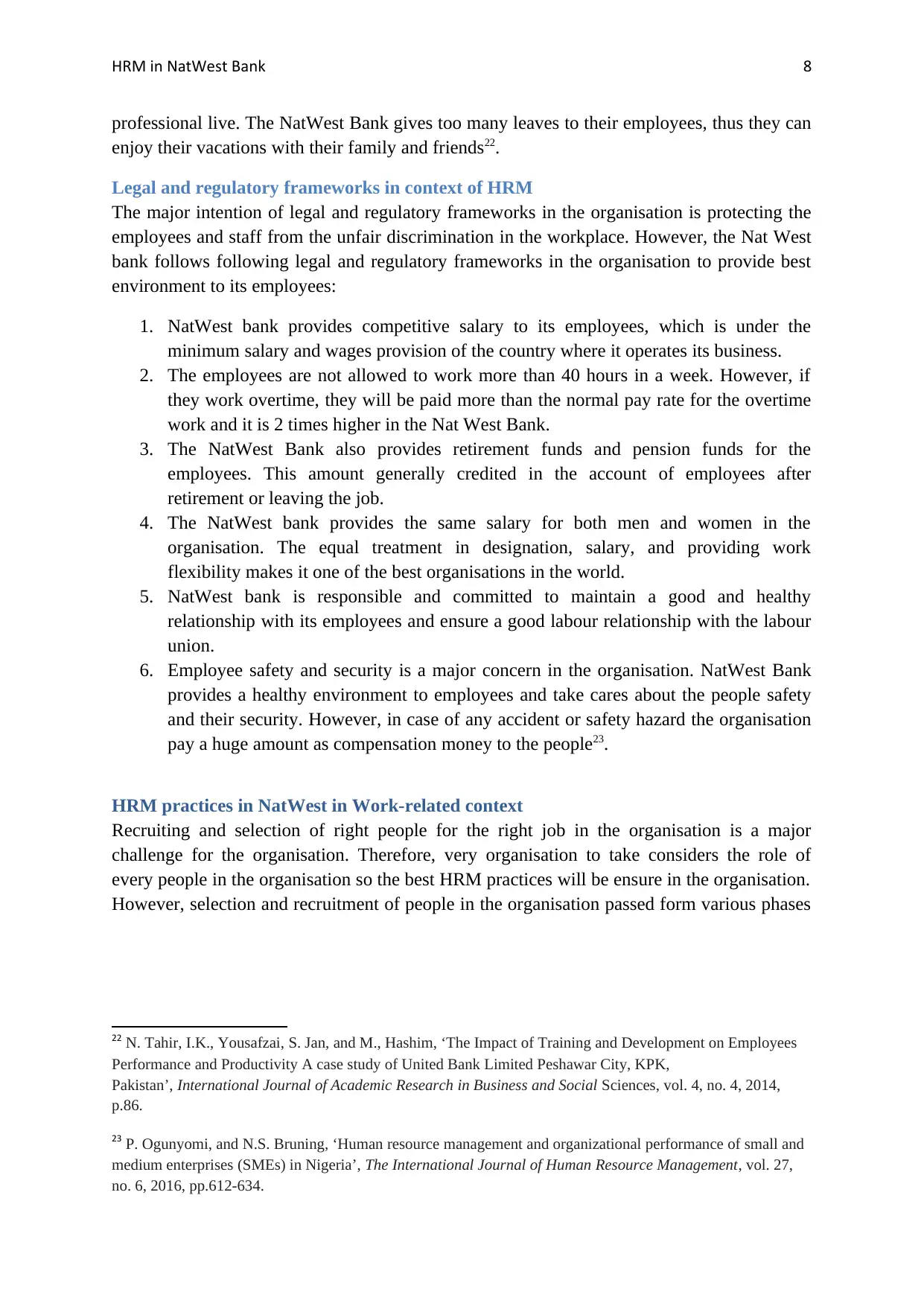
HRM in NatWest Bank 8
professional live. The NatWest Bank gives too many leaves to their employees, thus they can
enjoy their vacations with their family and friends22.
Legal and regulatory frameworks in context of HRM
The major intention of legal and regulatory frameworks in the organisation is protecting the
employees and staff from the unfair discrimination in the workplace. However, the Nat West
bank follows following legal and regulatory frameworks in the organisation to provide best
environment to its employees:
1. NatWest bank provides competitive salary to its employees, which is under the
minimum salary and wages provision of the country where it operates its business.
2. The employees are not allowed to work more than 40 hours in a week. However, if
they work overtime, they will be paid more than the normal pay rate for the overtime
work and it is 2 times higher in the Nat West Bank.
3. The NatWest Bank also provides retirement funds and pension funds for the
employees. This amount generally credited in the account of employees after
retirement or leaving the job.
4. The NatWest bank provides the same salary for both men and women in the
organisation. The equal treatment in designation, salary, and providing work
flexibility makes it one of the best organisations in the world.
5. NatWest bank is responsible and committed to maintain a good and healthy
relationship with its employees and ensure a good labour relationship with the labour
union.
6. Employee safety and security is a major concern in the organisation. NatWest Bank
provides a healthy environment to employees and take cares about the people safety
and their security. However, in case of any accident or safety hazard the organisation
pay a huge amount as compensation money to the people23.
HRM practices in NatWest in Work-related context
Recruiting and selection of right people for the right job in the organisation is a major
challenge for the organisation. Therefore, very organisation to take considers the role of
every people in the organisation so the best HRM practices will be ensure in the organisation.
However, selection and recruitment of people in the organisation passed form various phases
22 N. Tahir, I.K., Yousafzai, S. Jan, and M., Hashim, ‘The Impact of Training and Development on Employees
Performance and Productivity A case study of United Bank Limited Peshawar City, KPK,
Pakistan’, International Journal of Academic Research in Business and Social Sciences, vol. 4, no. 4, 2014,
p.86.
23 P. Ogunyomi, and N.S. Bruning, ‘Human resource management and organizational performance of small and
medium enterprises (SMEs) in Nigeria’, The International Journal of Human Resource Management, vol. 27,
no. 6, 2016, pp.612-634.
professional live. The NatWest Bank gives too many leaves to their employees, thus they can
enjoy their vacations with their family and friends22.
Legal and regulatory frameworks in context of HRM
The major intention of legal and regulatory frameworks in the organisation is protecting the
employees and staff from the unfair discrimination in the workplace. However, the Nat West
bank follows following legal and regulatory frameworks in the organisation to provide best
environment to its employees:
1. NatWest bank provides competitive salary to its employees, which is under the
minimum salary and wages provision of the country where it operates its business.
2. The employees are not allowed to work more than 40 hours in a week. However, if
they work overtime, they will be paid more than the normal pay rate for the overtime
work and it is 2 times higher in the Nat West Bank.
3. The NatWest Bank also provides retirement funds and pension funds for the
employees. This amount generally credited in the account of employees after
retirement or leaving the job.
4. The NatWest bank provides the same salary for both men and women in the
organisation. The equal treatment in designation, salary, and providing work
flexibility makes it one of the best organisations in the world.
5. NatWest bank is responsible and committed to maintain a good and healthy
relationship with its employees and ensure a good labour relationship with the labour
union.
6. Employee safety and security is a major concern in the organisation. NatWest Bank
provides a healthy environment to employees and take cares about the people safety
and their security. However, in case of any accident or safety hazard the organisation
pay a huge amount as compensation money to the people23.
HRM practices in NatWest in Work-related context
Recruiting and selection of right people for the right job in the organisation is a major
challenge for the organisation. Therefore, very organisation to take considers the role of
every people in the organisation so the best HRM practices will be ensure in the organisation.
However, selection and recruitment of people in the organisation passed form various phases
22 N. Tahir, I.K., Yousafzai, S. Jan, and M., Hashim, ‘The Impact of Training and Development on Employees
Performance and Productivity A case study of United Bank Limited Peshawar City, KPK,
Pakistan’, International Journal of Academic Research in Business and Social Sciences, vol. 4, no. 4, 2014,
p.86.
23 P. Ogunyomi, and N.S. Bruning, ‘Human resource management and organizational performance of small and
medium enterprises (SMEs) in Nigeria’, The International Journal of Human Resource Management, vol. 27,
no. 6, 2016, pp.612-634.
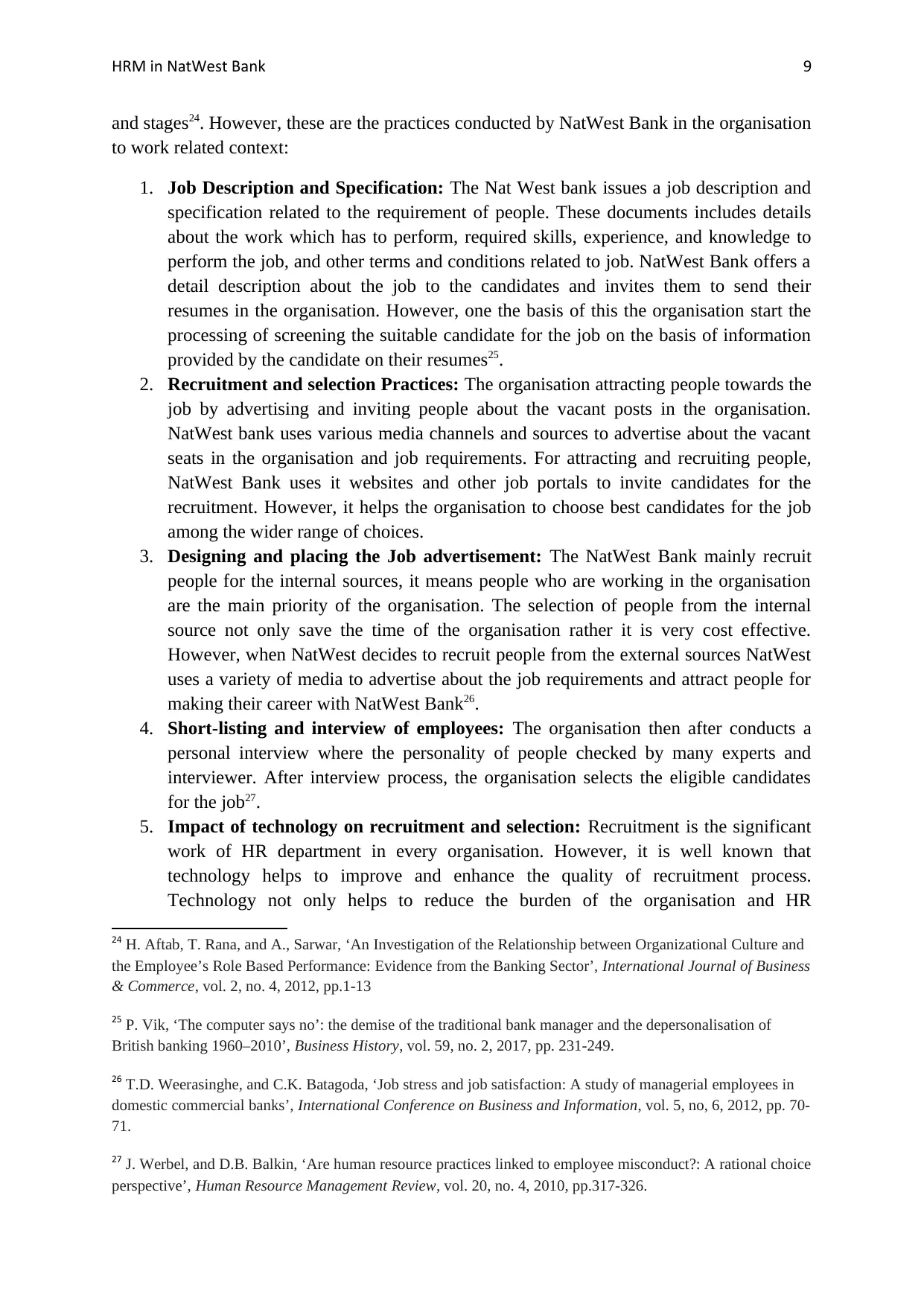
HRM in NatWest Bank 9
and stages24. However, these are the practices conducted by NatWest Bank in the organisation
to work related context:
1. Job Description and Specification: The Nat West bank issues a job description and
specification related to the requirement of people. These documents includes details
about the work which has to perform, required skills, experience, and knowledge to
perform the job, and other terms and conditions related to job. NatWest Bank offers a
detail description about the job to the candidates and invites them to send their
resumes in the organisation. However, one the basis of this the organisation start the
processing of screening the suitable candidate for the job on the basis of information
provided by the candidate on their resumes25.
2. Recruitment and selection Practices: The organisation attracting people towards the
job by advertising and inviting people about the vacant posts in the organisation.
NatWest bank uses various media channels and sources to advertise about the vacant
seats in the organisation and job requirements. For attracting and recruiting people,
NatWest Bank uses it websites and other job portals to invite candidates for the
recruitment. However, it helps the organisation to choose best candidates for the job
among the wider range of choices.
3. Designing and placing the Job advertisement: The NatWest Bank mainly recruit
people for the internal sources, it means people who are working in the organisation
are the main priority of the organisation. The selection of people from the internal
source not only save the time of the organisation rather it is very cost effective.
However, when NatWest decides to recruit people from the external sources NatWest
uses a variety of media to advertise about the job requirements and attract people for
making their career with NatWest Bank26.
4. Short-listing and interview of employees: The organisation then after conducts a
personal interview where the personality of people checked by many experts and
interviewer. After interview process, the organisation selects the eligible candidates
for the job27.
5. Impact of technology on recruitment and selection: Recruitment is the significant
work of HR department in every organisation. However, it is well known that
technology helps to improve and enhance the quality of recruitment process.
Technology not only helps to reduce the burden of the organisation and HR
24 H. Aftab, T. Rana, and A., Sarwar, ‘An Investigation of the Relationship between Organizational Culture and
the Employee’s Role Based Performance: Evidence from the Banking Sector’, International Journal of Business
& Commerce, vol. 2, no. 4, 2012, pp.1-13
25 P. Vik, ‘The computer says no’: the demise of the traditional bank manager and the depersonalisation of
British banking 1960–2010’, Business History, vol. 59, no. 2, 2017, pp. 231-249.
26 T.D. Weerasinghe, and C.K. Batagoda, ‘Job stress and job satisfaction: A study of managerial employees in
domestic commercial banks’, International Conference on Business and Information, vol. 5, no, 6, 2012, pp. 70-
71.
27 J. Werbel, and D.B. Balkin, ‘Are human resource practices linked to employee misconduct?: A rational choice
perspective’, Human Resource Management Review, vol. 20, no. 4, 2010, pp.317-326.
and stages24. However, these are the practices conducted by NatWest Bank in the organisation
to work related context:
1. Job Description and Specification: The Nat West bank issues a job description and
specification related to the requirement of people. These documents includes details
about the work which has to perform, required skills, experience, and knowledge to
perform the job, and other terms and conditions related to job. NatWest Bank offers a
detail description about the job to the candidates and invites them to send their
resumes in the organisation. However, one the basis of this the organisation start the
processing of screening the suitable candidate for the job on the basis of information
provided by the candidate on their resumes25.
2. Recruitment and selection Practices: The organisation attracting people towards the
job by advertising and inviting people about the vacant posts in the organisation.
NatWest bank uses various media channels and sources to advertise about the vacant
seats in the organisation and job requirements. For attracting and recruiting people,
NatWest Bank uses it websites and other job portals to invite candidates for the
recruitment. However, it helps the organisation to choose best candidates for the job
among the wider range of choices.
3. Designing and placing the Job advertisement: The NatWest Bank mainly recruit
people for the internal sources, it means people who are working in the organisation
are the main priority of the organisation. The selection of people from the internal
source not only save the time of the organisation rather it is very cost effective.
However, when NatWest decides to recruit people from the external sources NatWest
uses a variety of media to advertise about the job requirements and attract people for
making their career with NatWest Bank26.
4. Short-listing and interview of employees: The organisation then after conducts a
personal interview where the personality of people checked by many experts and
interviewer. After interview process, the organisation selects the eligible candidates
for the job27.
5. Impact of technology on recruitment and selection: Recruitment is the significant
work of HR department in every organisation. However, it is well known that
technology helps to improve and enhance the quality of recruitment process.
Technology not only helps to reduce the burden of the organisation and HR
24 H. Aftab, T. Rana, and A., Sarwar, ‘An Investigation of the Relationship between Organizational Culture and
the Employee’s Role Based Performance: Evidence from the Banking Sector’, International Journal of Business
& Commerce, vol. 2, no. 4, 2012, pp.1-13
25 P. Vik, ‘The computer says no’: the demise of the traditional bank manager and the depersonalisation of
British banking 1960–2010’, Business History, vol. 59, no. 2, 2017, pp. 231-249.
26 T.D. Weerasinghe, and C.K. Batagoda, ‘Job stress and job satisfaction: A study of managerial employees in
domestic commercial banks’, International Conference on Business and Information, vol. 5, no, 6, 2012, pp. 70-
71.
27 J. Werbel, and D.B. Balkin, ‘Are human resource practices linked to employee misconduct?: A rational choice
perspective’, Human Resource Management Review, vol. 20, no. 4, 2010, pp.317-326.
Secure Best Marks with AI Grader
Need help grading? Try our AI Grader for instant feedback on your assignments.
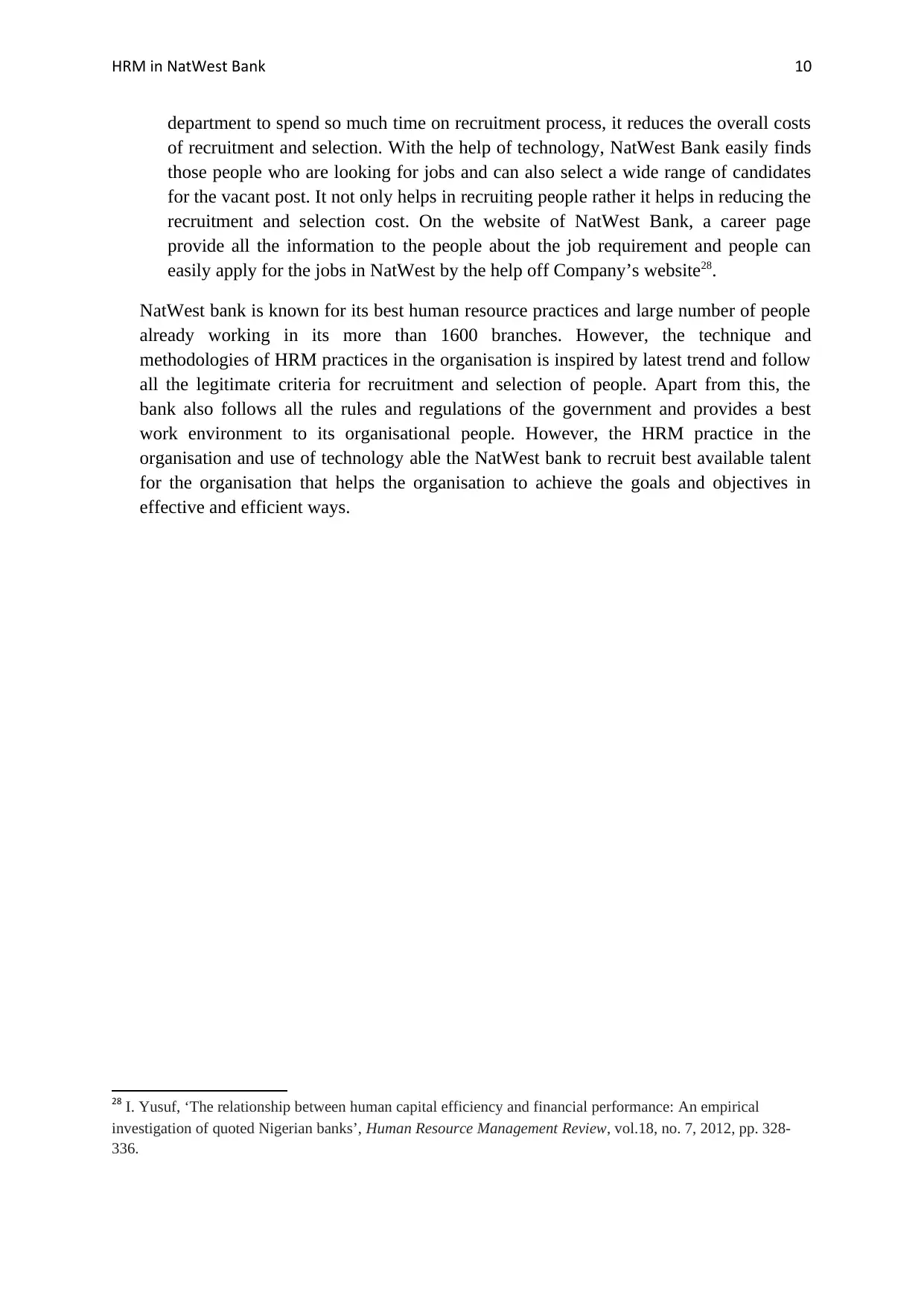
HRM in NatWest Bank 10
department to spend so much time on recruitment process, it reduces the overall costs
of recruitment and selection. With the help of technology, NatWest Bank easily finds
those people who are looking for jobs and can also select a wide range of candidates
for the vacant post. It not only helps in recruiting people rather it helps in reducing the
recruitment and selection cost. On the website of NatWest Bank, a career page
provide all the information to the people about the job requirement and people can
easily apply for the jobs in NatWest by the help off Company’s website28.
NatWest bank is known for its best human resource practices and large number of people
already working in its more than 1600 branches. However, the technique and
methodologies of HRM practices in the organisation is inspired by latest trend and follow
all the legitimate criteria for recruitment and selection of people. Apart from this, the
bank also follows all the rules and regulations of the government and provides a best
work environment to its organisational people. However, the HRM practice in the
organisation and use of technology able the NatWest bank to recruit best available talent
for the organisation that helps the organisation to achieve the goals and objectives in
effective and efficient ways.
28 I. Yusuf, ‘The relationship between human capital efficiency and financial performance: An empirical
investigation of quoted Nigerian banks’, Human Resource Management Review, vol.18, no. 7, 2012, pp. 328-
336.
department to spend so much time on recruitment process, it reduces the overall costs
of recruitment and selection. With the help of technology, NatWest Bank easily finds
those people who are looking for jobs and can also select a wide range of candidates
for the vacant post. It not only helps in recruiting people rather it helps in reducing the
recruitment and selection cost. On the website of NatWest Bank, a career page
provide all the information to the people about the job requirement and people can
easily apply for the jobs in NatWest by the help off Company’s website28.
NatWest bank is known for its best human resource practices and large number of people
already working in its more than 1600 branches. However, the technique and
methodologies of HRM practices in the organisation is inspired by latest trend and follow
all the legitimate criteria for recruitment and selection of people. Apart from this, the
bank also follows all the rules and regulations of the government and provides a best
work environment to its organisational people. However, the HRM practice in the
organisation and use of technology able the NatWest bank to recruit best available talent
for the organisation that helps the organisation to achieve the goals and objectives in
effective and efficient ways.
28 I. Yusuf, ‘The relationship between human capital efficiency and financial performance: An empirical
investigation of quoted Nigerian banks’, Human Resource Management Review, vol.18, no. 7, 2012, pp. 328-
336.
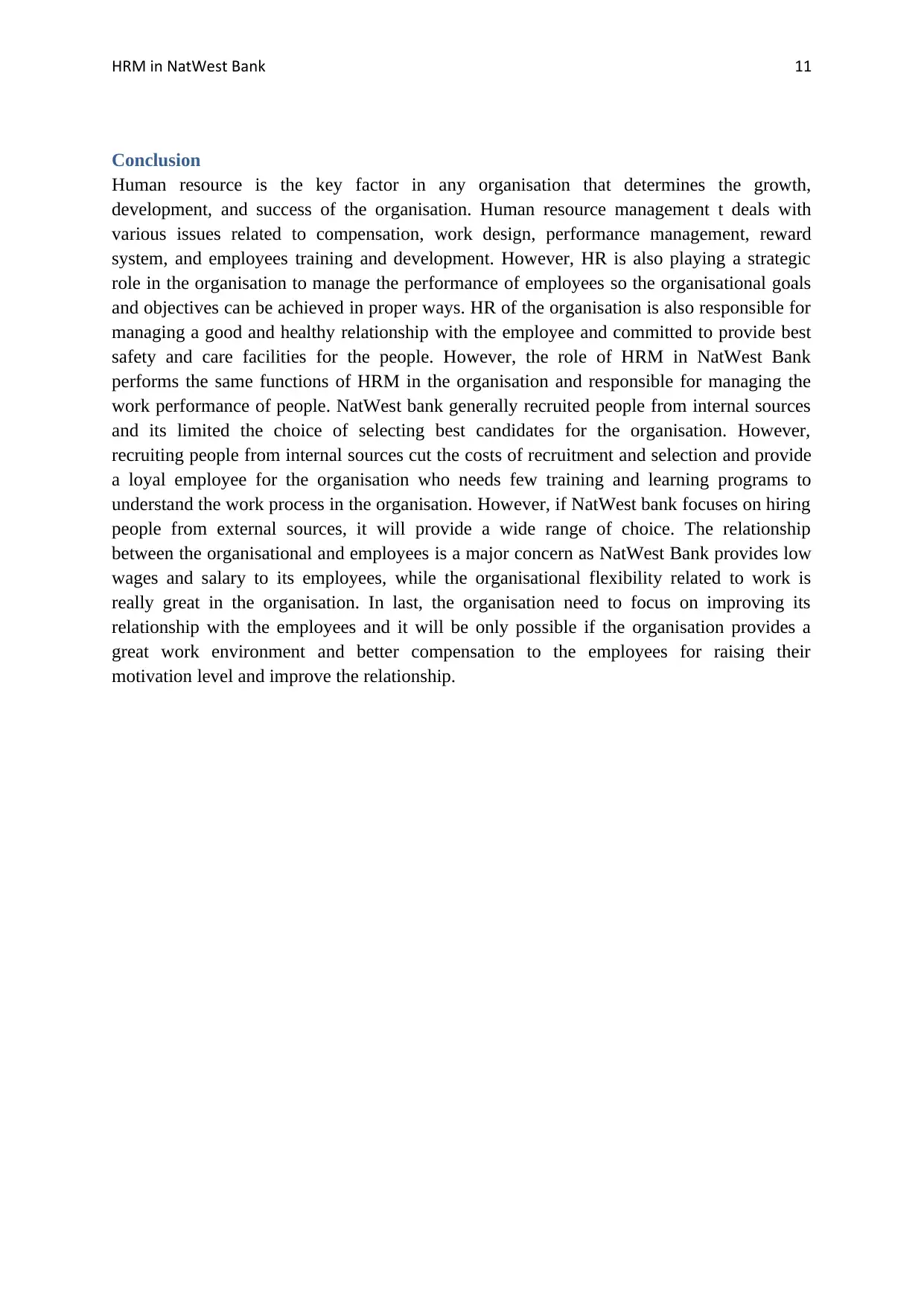
HRM in NatWest Bank 11
Conclusion
Human resource is the key factor in any organisation that determines the growth,
development, and success of the organisation. Human resource management t deals with
various issues related to compensation, work design, performance management, reward
system, and employees training and development. However, HR is also playing a strategic
role in the organisation to manage the performance of employees so the organisational goals
and objectives can be achieved in proper ways. HR of the organisation is also responsible for
managing a good and healthy relationship with the employee and committed to provide best
safety and care facilities for the people. However, the role of HRM in NatWest Bank
performs the same functions of HRM in the organisation and responsible for managing the
work performance of people. NatWest bank generally recruited people from internal sources
and its limited the choice of selecting best candidates for the organisation. However,
recruiting people from internal sources cut the costs of recruitment and selection and provide
a loyal employee for the organisation who needs few training and learning programs to
understand the work process in the organisation. However, if NatWest bank focuses on hiring
people from external sources, it will provide a wide range of choice. The relationship
between the organisational and employees is a major concern as NatWest Bank provides low
wages and salary to its employees, while the organisational flexibility related to work is
really great in the organisation. In last, the organisation need to focus on improving its
relationship with the employees and it will be only possible if the organisation provides a
great work environment and better compensation to the employees for raising their
motivation level and improve the relationship.
Conclusion
Human resource is the key factor in any organisation that determines the growth,
development, and success of the organisation. Human resource management t deals with
various issues related to compensation, work design, performance management, reward
system, and employees training and development. However, HR is also playing a strategic
role in the organisation to manage the performance of employees so the organisational goals
and objectives can be achieved in proper ways. HR of the organisation is also responsible for
managing a good and healthy relationship with the employee and committed to provide best
safety and care facilities for the people. However, the role of HRM in NatWest Bank
performs the same functions of HRM in the organisation and responsible for managing the
work performance of people. NatWest bank generally recruited people from internal sources
and its limited the choice of selecting best candidates for the organisation. However,
recruiting people from internal sources cut the costs of recruitment and selection and provide
a loyal employee for the organisation who needs few training and learning programs to
understand the work process in the organisation. However, if NatWest bank focuses on hiring
people from external sources, it will provide a wide range of choice. The relationship
between the organisational and employees is a major concern as NatWest Bank provides low
wages and salary to its employees, while the organisational flexibility related to work is
really great in the organisation. In last, the organisation need to focus on improving its
relationship with the employees and it will be only possible if the organisation provides a
great work environment and better compensation to the employees for raising their
motivation level and improve the relationship.
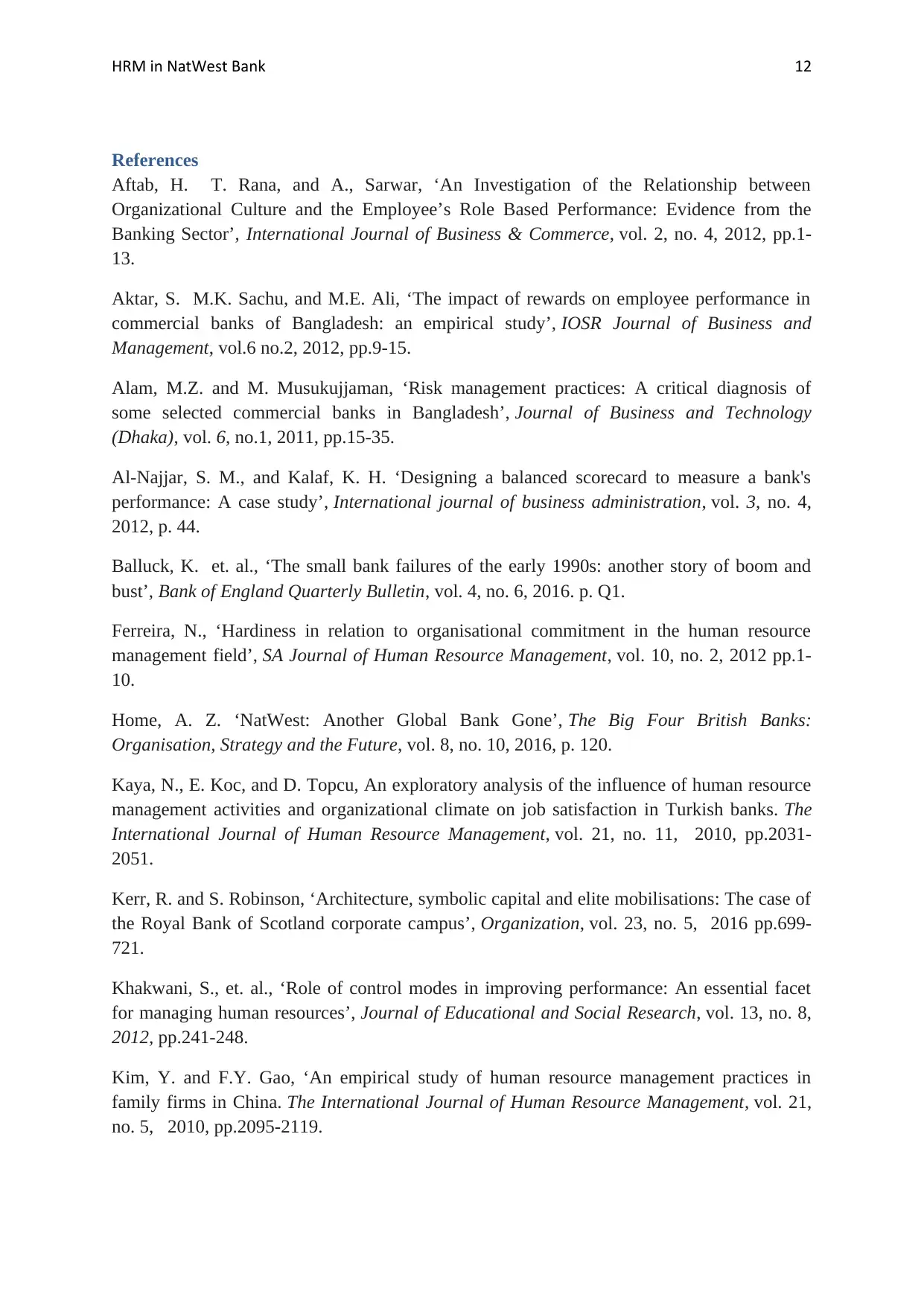
HRM in NatWest Bank 12
References
Aftab, H. T. Rana, and A., Sarwar, ‘An Investigation of the Relationship between
Organizational Culture and the Employee’s Role Based Performance: Evidence from the
Banking Sector’, International Journal of Business & Commerce, vol. 2, no. 4, 2012, pp.1-
13.
Aktar, S. M.K. Sachu, and M.E. Ali, ‘The impact of rewards on employee performance in
commercial banks of Bangladesh: an empirical study’, IOSR Journal of Business and
Management, vol.6 no.2, 2012, pp.9-15.
Alam, M.Z. and M. Musukujjaman, ‘Risk management practices: A critical diagnosis of
some selected commercial banks in Bangladesh’, Journal of Business and Technology
(Dhaka), vol. 6, no.1, 2011, pp.15-35.
Al-Najjar, S. M., and Kalaf, K. H. ‘Designing a balanced scorecard to measure a bank's
performance: A case study’, International journal of business administration, vol. 3, no. 4,
2012, p. 44.
Balluck, K. et. al., ‘The small bank failures of the early 1990s: another story of boom and
bust’, Bank of England Quarterly Bulletin, vol. 4, no. 6, 2016. p. Q1.
Ferreira, N., ‘Hardiness in relation to organisational commitment in the human resource
management field’, SA Journal of Human Resource Management, vol. 10, no. 2, 2012 pp.1-
10.
Home, A. Z. ‘NatWest: Another Global Bank Gone’, The Big Four British Banks:
Organisation, Strategy and the Future, vol. 8, no. 10, 2016, p. 120.
Kaya, N., E. Koc, and D. Topcu, An exploratory analysis of the influence of human resource
management activities and organizational climate on job satisfaction in Turkish banks. The
International Journal of Human Resource Management, vol. 21, no. 11, 2010, pp.2031-
2051.
Kerr, R. and S. Robinson, ‘Architecture, symbolic capital and elite mobilisations: The case of
the Royal Bank of Scotland corporate campus’, Organization, vol. 23, no. 5, 2016 pp.699-
721.
Khakwani, S., et. al., ‘Role of control modes in improving performance: An essential facet
for managing human resources’, Journal of Educational and Social Research, vol. 13, no. 8,
2012, pp.241-248.
Kim, Y. and F.Y. Gao, ‘An empirical study of human resource management practices in
family firms in China. The International Journal of Human Resource Management, vol. 21,
no. 5, 2010, pp.2095-2119.
References
Aftab, H. T. Rana, and A., Sarwar, ‘An Investigation of the Relationship between
Organizational Culture and the Employee’s Role Based Performance: Evidence from the
Banking Sector’, International Journal of Business & Commerce, vol. 2, no. 4, 2012, pp.1-
13.
Aktar, S. M.K. Sachu, and M.E. Ali, ‘The impact of rewards on employee performance in
commercial banks of Bangladesh: an empirical study’, IOSR Journal of Business and
Management, vol.6 no.2, 2012, pp.9-15.
Alam, M.Z. and M. Musukujjaman, ‘Risk management practices: A critical diagnosis of
some selected commercial banks in Bangladesh’, Journal of Business and Technology
(Dhaka), vol. 6, no.1, 2011, pp.15-35.
Al-Najjar, S. M., and Kalaf, K. H. ‘Designing a balanced scorecard to measure a bank's
performance: A case study’, International journal of business administration, vol. 3, no. 4,
2012, p. 44.
Balluck, K. et. al., ‘The small bank failures of the early 1990s: another story of boom and
bust’, Bank of England Quarterly Bulletin, vol. 4, no. 6, 2016. p. Q1.
Ferreira, N., ‘Hardiness in relation to organisational commitment in the human resource
management field’, SA Journal of Human Resource Management, vol. 10, no. 2, 2012 pp.1-
10.
Home, A. Z. ‘NatWest: Another Global Bank Gone’, The Big Four British Banks:
Organisation, Strategy and the Future, vol. 8, no. 10, 2016, p. 120.
Kaya, N., E. Koc, and D. Topcu, An exploratory analysis of the influence of human resource
management activities and organizational climate on job satisfaction in Turkish banks. The
International Journal of Human Resource Management, vol. 21, no. 11, 2010, pp.2031-
2051.
Kerr, R. and S. Robinson, ‘Architecture, symbolic capital and elite mobilisations: The case of
the Royal Bank of Scotland corporate campus’, Organization, vol. 23, no. 5, 2016 pp.699-
721.
Khakwani, S., et. al., ‘Role of control modes in improving performance: An essential facet
for managing human resources’, Journal of Educational and Social Research, vol. 13, no. 8,
2012, pp.241-248.
Kim, Y. and F.Y. Gao, ‘An empirical study of human resource management practices in
family firms in China. The International Journal of Human Resource Management, vol. 21,
no. 5, 2010, pp.2095-2119.
Paraphrase This Document
Need a fresh take? Get an instant paraphrase of this document with our AI Paraphraser
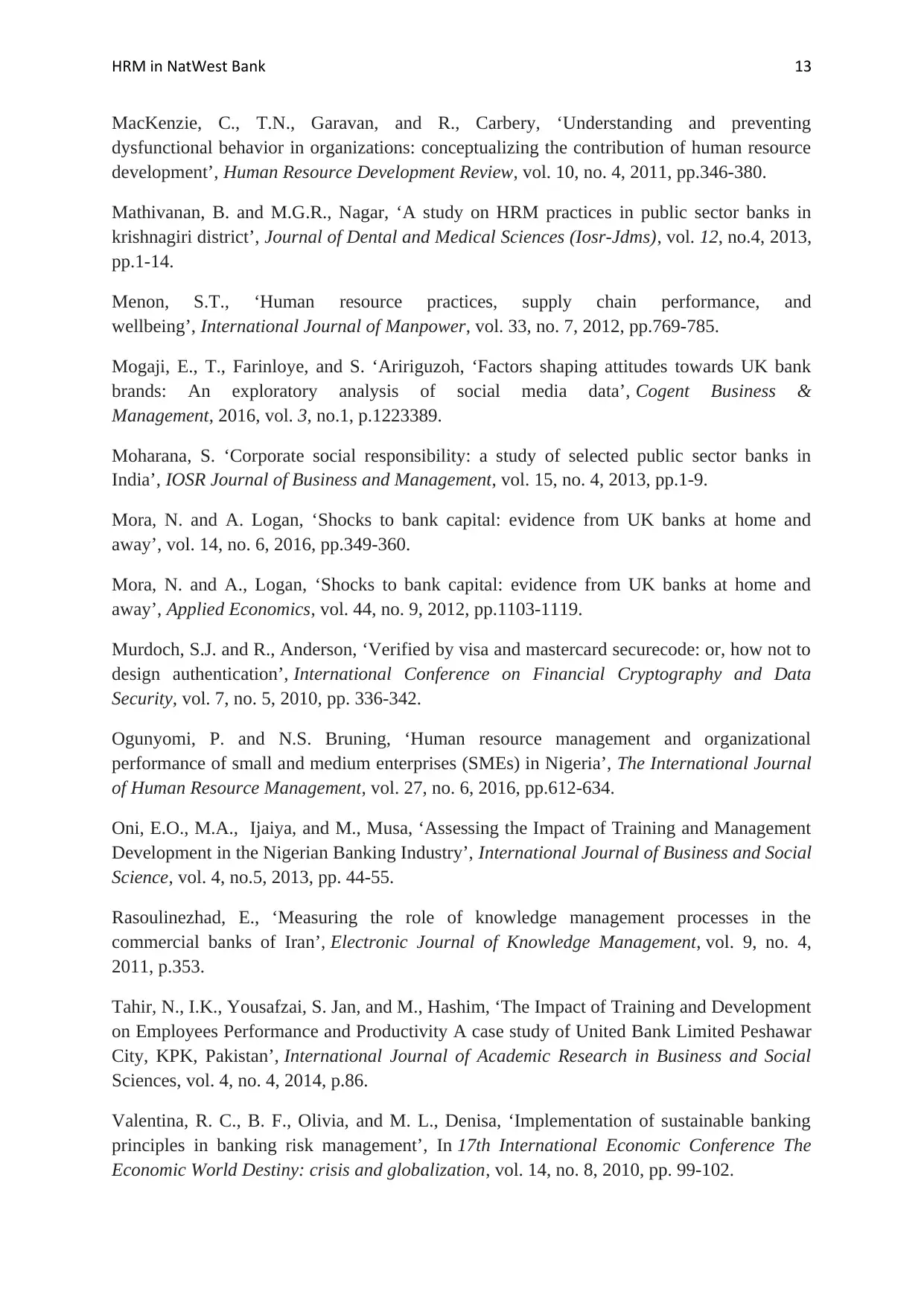
HRM in NatWest Bank 13
MacKenzie, C., T.N., Garavan, and R., Carbery, ‘Understanding and preventing
dysfunctional behavior in organizations: conceptualizing the contribution of human resource
development’, Human Resource Development Review, vol. 10, no. 4, 2011, pp.346-380.
Mathivanan, B. and M.G.R., Nagar, ‘A study on HRM practices in public sector banks in
krishnagiri district’, Journal of Dental and Medical Sciences (Iosr-Jdms), vol. 12, no.4, 2013,
pp.1-14.
Menon, S.T., ‘Human resource practices, supply chain performance, and
wellbeing’, International Journal of Manpower, vol. 33, no. 7, 2012, pp.769-785.
Mogaji, E., T., Farinloye, and S. ‘Aririguzoh, ‘Factors shaping attitudes towards UK bank
brands: An exploratory analysis of social media data’, Cogent Business &
Management, 2016, vol. 3, no.1, p.1223389.
Moharana, S. ‘Corporate social responsibility: a study of selected public sector banks in
India’, IOSR Journal of Business and Management, vol. 15, no. 4, 2013, pp.1-9.
Mora, N. and A. Logan, ‘Shocks to bank capital: evidence from UK banks at home and
away’, vol. 14, no. 6, 2016, pp.349-360.
Mora, N. and A., Logan, ‘Shocks to bank capital: evidence from UK banks at home and
away’, Applied Economics, vol. 44, no. 9, 2012, pp.1103-1119.
Murdoch, S.J. and R., Anderson, ‘Verified by visa and mastercard securecode: or, how not to
design authentication’, International Conference on Financial Cryptography and Data
Security, vol. 7, no. 5, 2010, pp. 336-342.
Ogunyomi, P. and N.S. Bruning, ‘Human resource management and organizational
performance of small and medium enterprises (SMEs) in Nigeria’, The International Journal
of Human Resource Management, vol. 27, no. 6, 2016, pp.612-634.
Oni, E.O., M.A., Ijaiya, and M., Musa, ‘Assessing the Impact of Training and Management
Development in the Nigerian Banking Industry’, International Journal of Business and Social
Science, vol. 4, no.5, 2013, pp. 44-55.
Rasoulinezhad, E., ‘Measuring the role of knowledge management processes in the
commercial banks of Iran’, Electronic Journal of Knowledge Management, vol. 9, no. 4,
2011, p.353.
Tahir, N., I.K., Yousafzai, S. Jan, and M., Hashim, ‘The Impact of Training and Development
on Employees Performance and Productivity A case study of United Bank Limited Peshawar
City, KPK, Pakistan’, International Journal of Academic Research in Business and Social
Sciences, vol. 4, no. 4, 2014, p.86.
Valentina, R. C., B. F., Olivia, and M. L., Denisa, ‘Implementation of sustainable banking
principles in banking risk management’, In 17th International Economic Conference The
Economic World Destiny: crisis and globalization, vol. 14, no. 8, 2010, pp. 99-102.
MacKenzie, C., T.N., Garavan, and R., Carbery, ‘Understanding and preventing
dysfunctional behavior in organizations: conceptualizing the contribution of human resource
development’, Human Resource Development Review, vol. 10, no. 4, 2011, pp.346-380.
Mathivanan, B. and M.G.R., Nagar, ‘A study on HRM practices in public sector banks in
krishnagiri district’, Journal of Dental and Medical Sciences (Iosr-Jdms), vol. 12, no.4, 2013,
pp.1-14.
Menon, S.T., ‘Human resource practices, supply chain performance, and
wellbeing’, International Journal of Manpower, vol. 33, no. 7, 2012, pp.769-785.
Mogaji, E., T., Farinloye, and S. ‘Aririguzoh, ‘Factors shaping attitudes towards UK bank
brands: An exploratory analysis of social media data’, Cogent Business &
Management, 2016, vol. 3, no.1, p.1223389.
Moharana, S. ‘Corporate social responsibility: a study of selected public sector banks in
India’, IOSR Journal of Business and Management, vol. 15, no. 4, 2013, pp.1-9.
Mora, N. and A. Logan, ‘Shocks to bank capital: evidence from UK banks at home and
away’, vol. 14, no. 6, 2016, pp.349-360.
Mora, N. and A., Logan, ‘Shocks to bank capital: evidence from UK banks at home and
away’, Applied Economics, vol. 44, no. 9, 2012, pp.1103-1119.
Murdoch, S.J. and R., Anderson, ‘Verified by visa and mastercard securecode: or, how not to
design authentication’, International Conference on Financial Cryptography and Data
Security, vol. 7, no. 5, 2010, pp. 336-342.
Ogunyomi, P. and N.S. Bruning, ‘Human resource management and organizational
performance of small and medium enterprises (SMEs) in Nigeria’, The International Journal
of Human Resource Management, vol. 27, no. 6, 2016, pp.612-634.
Oni, E.O., M.A., Ijaiya, and M., Musa, ‘Assessing the Impact of Training and Management
Development in the Nigerian Banking Industry’, International Journal of Business and Social
Science, vol. 4, no.5, 2013, pp. 44-55.
Rasoulinezhad, E., ‘Measuring the role of knowledge management processes in the
commercial banks of Iran’, Electronic Journal of Knowledge Management, vol. 9, no. 4,
2011, p.353.
Tahir, N., I.K., Yousafzai, S. Jan, and M., Hashim, ‘The Impact of Training and Development
on Employees Performance and Productivity A case study of United Bank Limited Peshawar
City, KPK, Pakistan’, International Journal of Academic Research in Business and Social
Sciences, vol. 4, no. 4, 2014, p.86.
Valentina, R. C., B. F., Olivia, and M. L., Denisa, ‘Implementation of sustainable banking
principles in banking risk management’, In 17th International Economic Conference The
Economic World Destiny: crisis and globalization, vol. 14, no. 8, 2010, pp. 99-102.

HRM in NatWest Bank 14
Vik, P. ‘The computer says no’: the demise of the traditional bank manager and the
depersonalisation of British banking 1960–2010’, Business History, vol. 59, no. 2, 2017, pp.
231-249.
Weerasinghe, T.D. and C.K. Batagoda, ‘Job stress and job satisfaction: A study of managerial
employees in domestic commercial banks’, International Conference on Business and
Information, vol. 5, no, 6, 2012, pp. 70-71.
Werbel, J. and D.B. Balkin, ‘Are human resource practices linked to employee misconduct?:
A rational choice perspective’, Human Resource Management Review, vol. 20, no. 4, 2010,
pp.317-326.
Yusuf, I., ‘The relationship between human capital efficiency and financial performance: An
empirical investigation of quoted Nigerian banks’, Human Resource Management
Review, vol.18, no. 7, 2012, pp. 328-336.
Vik, P. ‘The computer says no’: the demise of the traditional bank manager and the
depersonalisation of British banking 1960–2010’, Business History, vol. 59, no. 2, 2017, pp.
231-249.
Weerasinghe, T.D. and C.K. Batagoda, ‘Job stress and job satisfaction: A study of managerial
employees in domestic commercial banks’, International Conference on Business and
Information, vol. 5, no, 6, 2012, pp. 70-71.
Werbel, J. and D.B. Balkin, ‘Are human resource practices linked to employee misconduct?:
A rational choice perspective’, Human Resource Management Review, vol. 20, no. 4, 2010,
pp.317-326.
Yusuf, I., ‘The relationship between human capital efficiency and financial performance: An
empirical investigation of quoted Nigerian banks’, Human Resource Management
Review, vol.18, no. 7, 2012, pp. 328-336.
1 out of 15
Related Documents
Your All-in-One AI-Powered Toolkit for Academic Success.
+13062052269
info@desklib.com
Available 24*7 on WhatsApp / Email
![[object Object]](/_next/static/media/star-bottom.7253800d.svg)
Unlock your academic potential
© 2024 | Zucol Services PVT LTD | All rights reserved.





